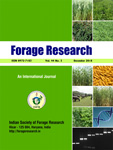AKANKSHA RAJ, M. K. SHARMA, K. K. BHARDWAJ AND SATPAL
Department of Soil Science,
Department of G & PB (Forage Section) CCS Haryana Agricultural University, Hisar-125 004 (Haryana), India
*(e-mail: akankshakirty09@gmail.com)
(Received: 20 September 2024; Accepted: 3 December 2024)
SUMMARY
Sorghum (Sorghum bicolor (L.) Monech) is a cereal grass that belongs to family Poaceae and is a widely cultivated as food and fodder crop. It is moderately salt tolerant crop; widely adaptive to various edapho-climatic conditions and provides digestible, palatable and nutritious fodder. India is home to 536.76 million livestock and is facing green and dry fodder deficit to the tune of 11.4 and 23.2 %, respectively. The crop is very exhaustive from nutrient point of view; and it removes 28.0-3.5-20.0 kg N-P-K per tonne of dry matter. The recommended dose of NPK for forage sorghum is 75 to 150 kg N, 30 to 50 kg P2O5 and 30 to 50 kg K2O per hectare which vary from single cut to multicut sorghum. These nutrients can be supplied through inorganic sources (synthetic fertilizers) and organic sources (FYM, vermicompost, bio-fertilizers, and manure). Continuous application of fertilizers can disturb the soil health in terms of soil structure, micro-flora and fauna. To maintain soil health, it is required to supply nutrients through organic sources alone or in combination with inorganic sources which improves physical, chemical and biological properties of soil and also adds nutrients to soil for growth and development of the crop. In physical properties, improvement of soil structure, porosity, chemical properties in terms of organic carbon content, nutrient status of soil and in biological property enhancement in the soil microbial population is needed for sustenance. But the sole nutrient requirement of the crop is not fulfilled due to the huge demand of the organic sources which it not possible in this era of increasing population. That’s why the combined application inorganic and organic source of nutrients improves the soil physico-chemical and biological properties and fulfills the nutrient requirement of the crop along with economical feasibility. Different combination of organic and inorganic nutrient sources like application of RDF along with bio-fertilizers, 100% dose of RDF through inorganic fertilizer+25% RDF through organic source, 75% dose of RDF through inorganic fertilizer+25% RDF through organic source, 50% dose of RDF through inorganic fertilizer+50% RDF through organic source have been studied and found to improve the soil health along with quality and yield advantage as compared to the sole application of inorganic fertilizers. However, the combinations are location, crop and variety specific and depend upon the available nutrients in the soil along with organic carbon content in sorghum.
Key words: Sorghum, organic nutrient, fertilizers, soil health, fodder yield and quality

